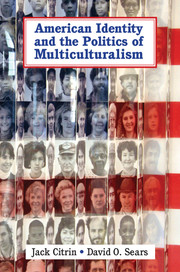39 results
The Realignment of Political Tolerance in the United States
-
- Journal:
- Perspectives on Politics / Volume 22 / Issue 1 / March 2024
- Published online by Cambridge University Press:
- 18 October 2022, pp. 131-152
- Print publication:
- March 2024
-
- Article
-
- You have access
- Open access
- HTML
- Export citation
Ethnoreligious Identity, Immigration, and Redistribution
-
- Journal:
- Journal of Experimental Political Science / Volume 4 / Issue 3 / Winter 2017
- Published online by Cambridge University Press:
- 13 October 2017, pp. 173-182
-
- Article
- Export citation
Mass Opinion and Immigration Policy in the United States: Re-Assessing Clientelist and Elitist Perspectives
-
- Journal:
- Perspectives on Politics / Volume 14 / Issue 3 / September 2016
- Published online by Cambridge University Press:
- 31 August 2016, pp. 660-680
- Print publication:
- September 2016
-
- Article
- Export citation
Index
-
- Book:
- American Identity and the Politics of Multiculturalism
- Published online:
- 05 September 2014
- Print publication:
- 11 August 2014, pp 311-322
-
- Chapter
- Export citation
List of Tables
-
- Book:
- American Identity and the Politics of Multiculturalism
- Published online:
- 05 September 2014
- Print publication:
- 11 August 2014, pp xi-xii
-
- Chapter
- Export citation
2 - The Political Psychology of Identity Choice
-
- Book:
- American Identity and the Politics of Multiculturalism
- Published online:
- 05 September 2014
- Print publication:
- 11 August 2014, pp 30-55
-
- Chapter
- Export citation
Prologue
-
- Book:
- American Identity and the Politics of Multiculturalism
- Published online:
- 05 September 2014
- Print publication:
- 11 August 2014, pp xvii-xxviii
-
- Chapter
- Export citation
8 - The Dynamics of Group-Conscious Policy Preferences
-
- Book:
- American Identity and the Politics of Multiculturalism
- Published online:
- 05 September 2014
- Print publication:
- 11 August 2014, pp 204-222
-
- Chapter
- Export citation
Frontmatter
-
- Book:
- American Identity and the Politics of Multiculturalism
- Published online:
- 05 September 2014
- Print publication:
- 11 August 2014, pp i-vi
-
- Chapter
- Export citation
Appendices
-
- Book:
- American Identity and the Politics of Multiculturalism
- Published online:
- 05 September 2014
- Print publication:
- 11 August 2014, pp 285-292
-
- Chapter
- Export citation
Bibliography
-
- Book:
- American Identity and the Politics of Multiculturalism
- Published online:
- 05 September 2014
- Print publication:
- 11 August 2014, pp 293-310
-
- Chapter
- Export citation
List of Figures
-
- Book:
- American Identity and the Politics of Multiculturalism
- Published online:
- 05 September 2014
- Print publication:
- 11 August 2014, pp x-x
-
- Chapter
- Export citation
7 - Group-Conscious Policies: Ethnic Consensus and Cleavage
-
- Book:
- American Identity and the Politics of Multiculturalism
- Published online:
- 05 September 2014
- Print publication:
- 11 August 2014, pp 175-203
-
- Chapter
- Export citation
Preface
-
- Book:
- American Identity and the Politics of Multiculturalism
- Published online:
- 05 September 2014
- Print publication:
- 11 August 2014, pp xiii-xvi
-
- Chapter
- Export citation
9 - Multiculturalism and Party Politics
-
- Book:
- American Identity and the Politics of Multiculturalism
- Published online:
- 05 September 2014
- Print publication:
- 11 August 2014, pp 223-260
-
- Chapter
- Export citation
4 - The Ethnic Cauldron and Group Consciousness
-
- Book:
- American Identity and the Politics of Multiculturalism
- Published online:
- 05 September 2014
- Print publication:
- 11 August 2014, pp 88-119
-
- Chapter
- Export citation
6 - When Do Ethnic and National Identities Collide?
-
- Book:
- American Identity and the Politics of Multiculturalism
- Published online:
- 05 September 2014
- Print publication:
- 11 August 2014, pp 145-174
-
- Chapter
- Export citation
5 - Public Opinion and Multiculturalism’s Guiding Norms
-
- Book:
- American Identity and the Politics of Multiculturalism
- Published online:
- 05 September 2014
- Print publication:
- 11 August 2014, pp 120-144
-
- Chapter
- Export citation

American Identity and the Politics of Multiculturalism
-
- Published online:
- 05 September 2014
- Print publication:
- 11 August 2014
Dedication
-
- Book:
- American Identity and the Politics of Multiculturalism
- Published online:
- 05 September 2014
- Print publication:
- 11 August 2014, pp vii-viii
-
- Chapter
- Export citation

